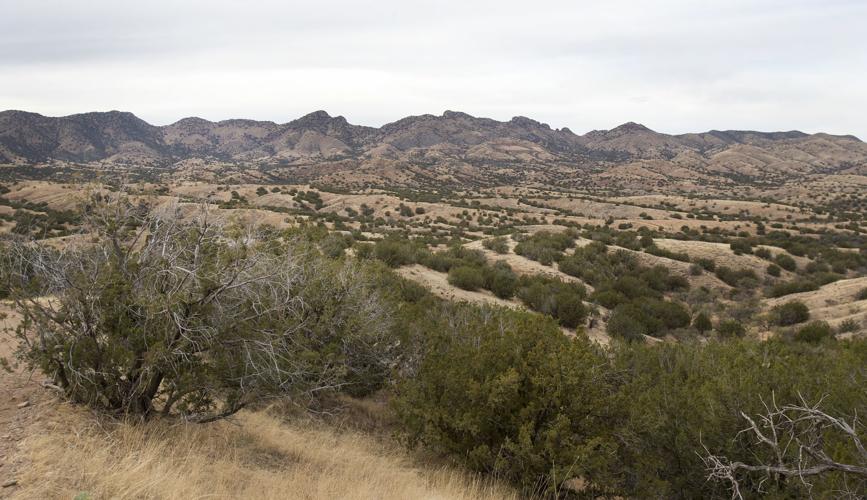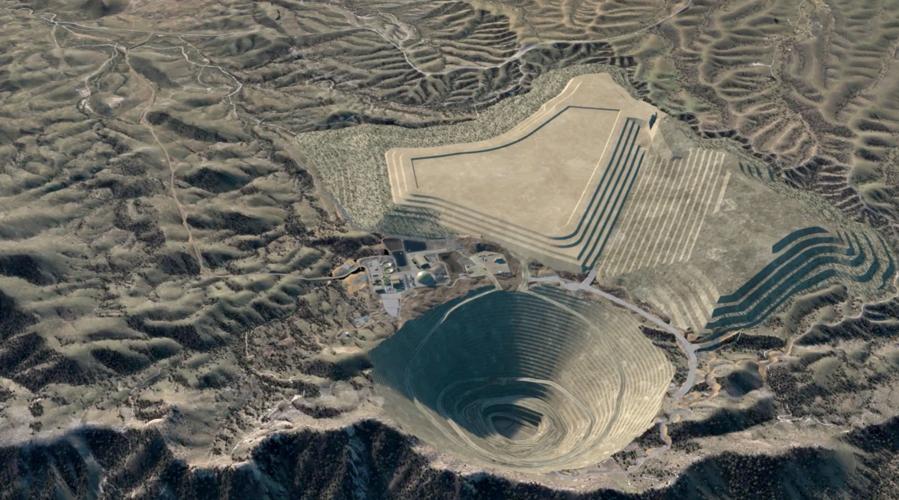The Rosemont Mine needs a federal Clean Water Act permit to start construction, an agency decided last month, in a reversal.
But a case pending before the U.S. Supreme Court could overturn that requirement — not only for the mine, but for thousands of other commercial and housing developments across the United States.
The high court agreed late last month to hear a Clean Water Act case involving home construction near a lake in Idaho.
Given the court’s 6-3 conservative majority, legal experts on both sides of this issue say it could undercut the Army Corps of Engineers’ authority to regulate the effects of developments on many wetlands and non-perennial streams, particularly in the arid Southwest.
This could include not only Rosemont’s proposed discharges of dredge and fill material into washes in the Santa Rita Mountains southeast of Tucson, but also a Phoenix developer’s 28,000-home Villages at Vigneto development in Benson.
Construction along washes
On Jan. 5, the Army Corps told Rosemont’s owner, Hudbay Minerals Inc., that it was overturning its previous decision that the agency lacked authority to regulate construction along 100 acres of washes running through the mine property.
The previous decision, in March 2021, was due mainly to the dominance of ephemeral streams — those that carry water only after rains — at the mine site.
Those are streams the Corps once regulated but did no longer under rules issued by the Trump administration.
The Trump rules, however, were tossed out in August 2021 by a federal judge in Tucson, an action that restored the Corps’ ability to regulate ephemeral streams.
U.S. District Judge Rosemary Marquez found that the Trump rule contained “fundamental flaws that cannot be cured” and that allowing it to stand risked triggering environmental harm across the United States.
That decision led directly to the Corps’ January 2022 policy reversal that affected not only Rosemont but numerous other pending Clean Water Act permits across the United States.
“This is an important step forward for the Army Corps, an acknowledgement that their earlier determination was flawed and improperly granted,” said Stu Gillespie, an attorney who represented tribes who were plaintiffs in the lawsuit Marquez ruled on. “It’s a big step forward for Arizona, an indication the waterways of Arizona will be protected. Nobody gets a free pass.”
Hudbay, however, noted that it had asked the Corps to determine it had no jurisdiction over the mine site before the Trump administration issued its rule in 2020.
“We strongly believed then, as we do now, that there was no jurisdiction” under the rules, even before the Trump administration changed them, Hudbay said in a statement.
The legal issues
On Jan. 24, the Supreme Court agreed to hear the Idaho case, which could again wipe out federal authority to lessen developments’ effects on ephemeral streams, as well as on intermittent streams that run part of the year.
The case involves a couple’s 14-year effort to build a single-family home near Priest Lake, a large, pristine mountain lake in the northern Idaho panhandle.
The feds’ authority over the home’s construction is based on many of the same legal theories underscoring federal control of the Rosemont Mine site.
The Sackett vs. the EPA Supreme Court case involves the Idaho couple’s effort to overturn an EPA decision in 2007 that their home construction needed a Clean Water Act permit because it would be on a “navigable waters” wetland the EPA said required regulation.
A U.S. District Court judge and the 9th Circuit Court of Appeals rejected Michael and Chantell Sackett’s challenge to the EPA’s decision, which led the couple to successfully petition the high court.
At issue is whether the court will preserve the current 16-year-old Supreme Court benchmark for determining whether a wetland or wash gets federal protection. Under it, wetlands and, by inference, other waterways, must have a significant “nexus,” or connection, with a navigable stream.
The Sacketts and their legal counsel, the Pacific Legal Foundation, want the court to use a much more restrictive standard, saying the current standard has provoked widespread confusion and uncertainty among the regulated builders and developers as to what’s legally acceptable.
Developed by the late Justice Antonin Scalia, the guidepost favored by the Sacketts would require a wash or wetland to be connected to a navigable waterway by a water body that carries surface water year-round.
As evidence of the high stakes, the Sacketts’ petition to the Supreme Court drew supporting legal briefs from Arizona and 20 other states, the National Association of Home Builders, the U.S. Chamber of Commerce and two conservative legal foundations that promote property rights and free market economics.
One expert, Vermont Law School professor Patrick Parenteau, who is generally sympathetic to environmentalists, said he fully expects the high court to side with Sackett against the more liberal 9th U.S. Circuit.
Otherwise, he said, “why would they take the case — to uphold it? No, they took the case to overturn the 9th Circuit.”
Damien Schiff, a senior counsel for the Pacific Legal Foundation, which is representing the Sacketts, said, “We certainly hope that the court will side with our view and believe that the court likely would not have taken the case had it been happy with the status quo, which is the ‘significant nexus’ test.” The nonprofit foundation says it “defends Americans from government overreach and abuse.”
Jonathan Adler, a law professor and legal commentator at Case Western Reserve University in Ohio, is an advocate of what he calls “free market environmentalism.” Referring to the West and Southwest, he said the case “could have big implications out there, if the court were to go in the direction of requiring a continuous or near continuous” surface water connection for streams to be regulated.
He said he thinks a decision in favor of the Sacketts is likely, “but a lot matters on how they do it. That will have a big impact on what degree of flexibility agencies have in drafting new regulations. It certainly creates the impression that the court is looking to clarify and narrow the scope of federal regulatory authority.”
Muddled precedent
Judge Marquez’s decision in Tucson, which wasn’t appealed, hinged on the precedent set by the controversial Rapanos v. U.S. decision in 2006.
The Rapanos case concerned a Michigan landowner who had started construction on a shopping center in an area the EPA considered to be a wetland, without getting a Clean Water Act permit.
The case created a rare, 4-4-1 high court split that left no clear majority opinion on what kinds of streams deserve federal regulation.
Scalia and three other justices found ephemeral streams and wetlands don’t warrant protection under the act unless they’re continuously connected by surface water with another regulated water body. As for tributaries, the Scalia opinion would have allowed them to be covered only if they had a “relatively permanent” presence of water.
Since-retired Justice Anthony Kennedy took a middle ground stance, calling for the “significant nexus” standard for determining federal jurisdiction over wetlands and, by inference, washes.
The other four justices took a more expansive view, arguing for combining the Scalia and Kennedy standards so a waterway could be protected if it met either one.
Court’s leanings
The Sacketts, like Rapanos, were stopped by EPA from building, this time on a lot the agency said is a wetland that adjoined a navigable water body, thus qualifying for Clean Water Act protection as what the act classifies as “waters of the United States.”
The couple had trucked in more than 1,700 cubic yards of sand and gravel to fill in a wetland, EPA said. EPA cited them as being in violation of the Clean Water Act and ordered the couple to remove the fill and to restore the wetland. The property lies across a road and some homes from a navigable water — which EPA says qualifies for Clean Water Act regulation.
The couple sued, arguing their property isn’t covered by the Clean Water Act.
“The record of the case is clear that the Sacketts’ lot contains no surface water connection to any water body,” their lawyers wrote in their petition to the Supreme Court to hear the case, harkening back to Scalia’s 2006 opinion.
In an article last summer for the libertarian-thinking Reason.com website, law professor Adler noted the three Supreme Court justices who sided with Scalia in 2006 remain on the court, and a fourth justice, Brett Kavanaugh, has already expressed “affinity” for Scalia’s view on another court ruling.
A fifth vote for a Scalia-like opinion would seem well within reach from Justices Neil Gorsuch or Amy Coney Barrett, both conservatives, Adler wrote.
That would eliminate almost all regulation, Parenteau said, because if the only water bodies deemed navigable were relatively permanent lakes, rivers and oceans, only 1% of all U.S. waters meet that definition.
Schiff, for his part, said some activists want regulation of virtually all wetlands by the EPA and the Corps under the Clean Water Act. “Our view is that Congress did not intend, and that the Constitution would not authorize, such an outcome,” he said.





